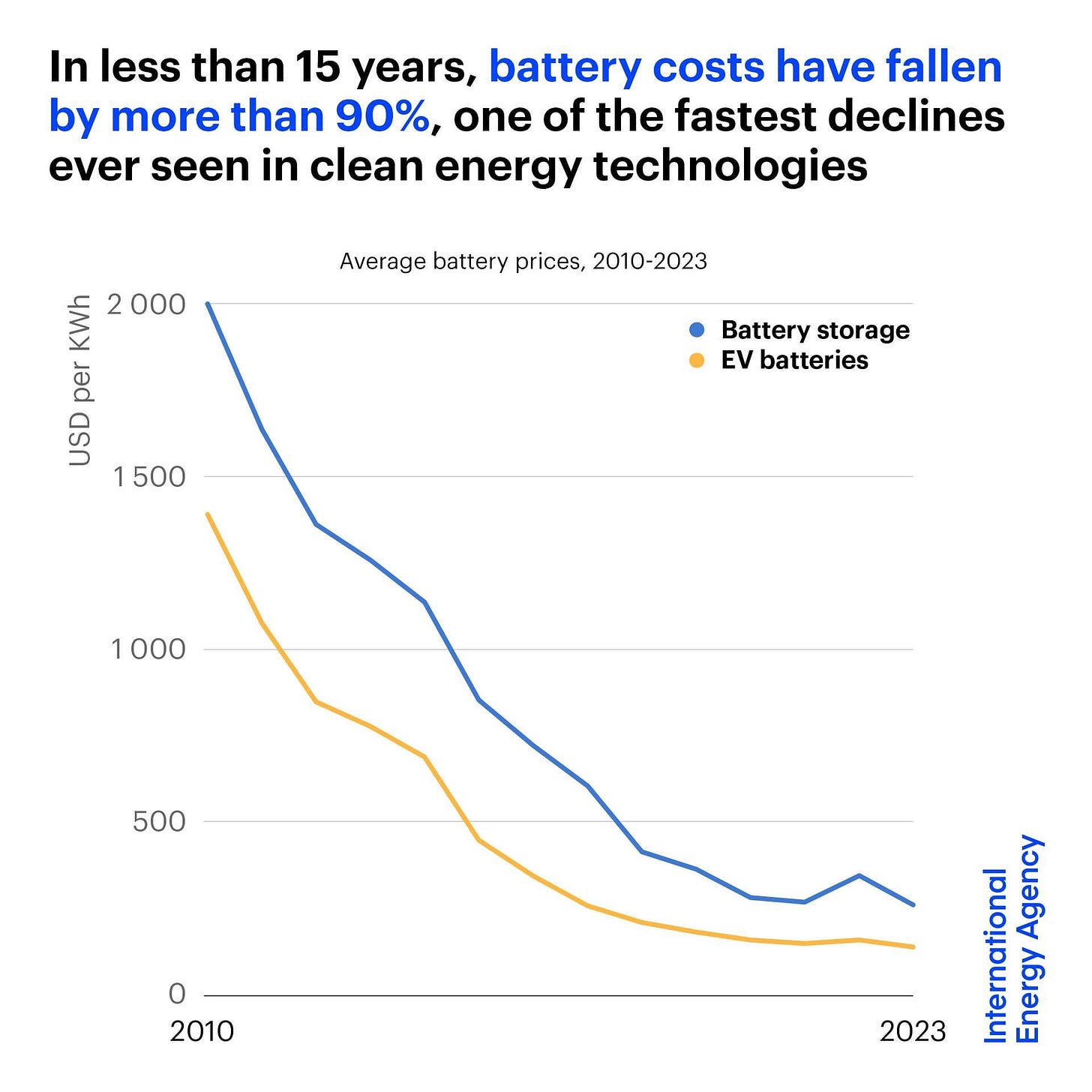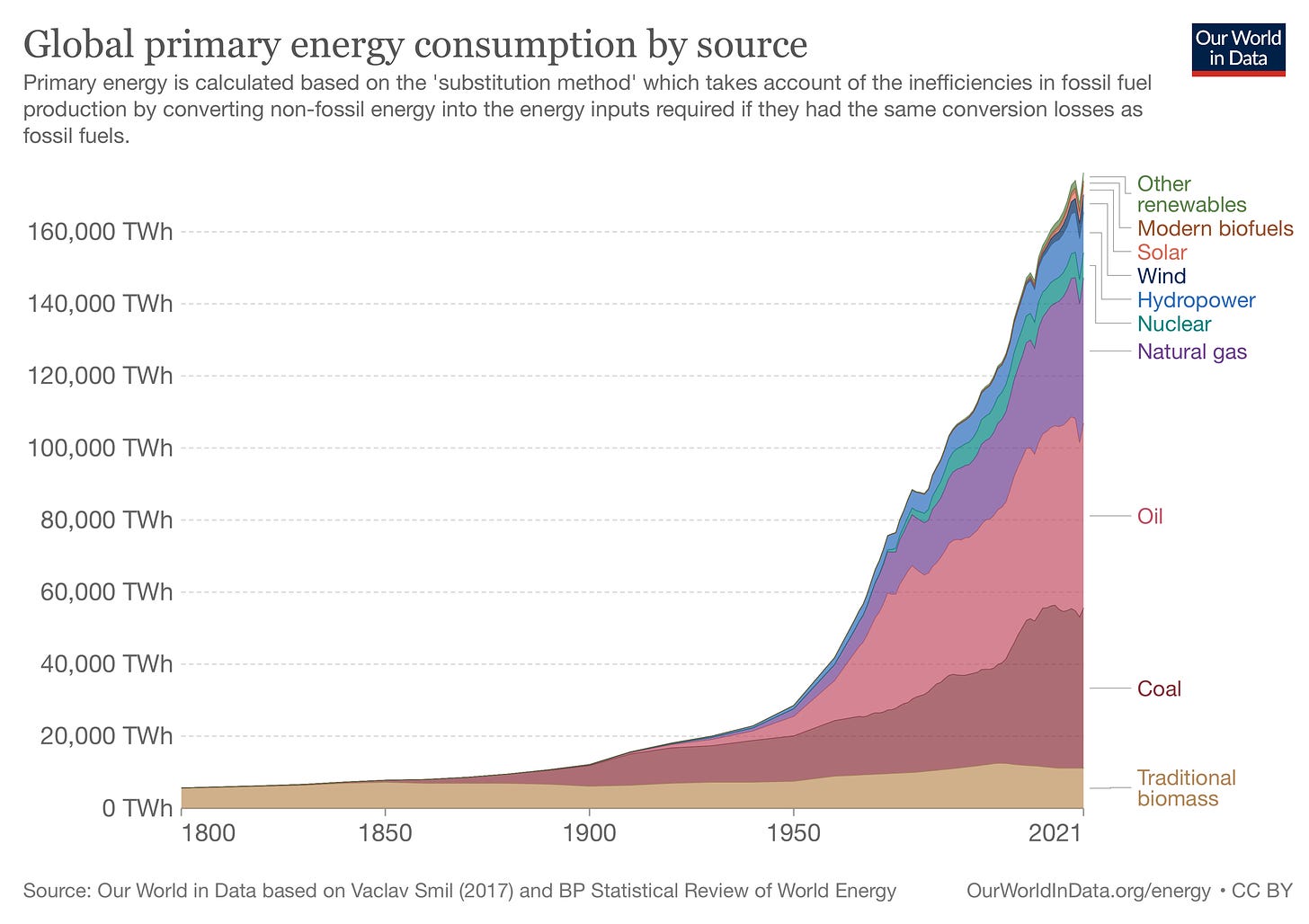The song that was inspired by this article is available here.
My reading this article as an audio podcast is available here.
The new car from Arizona carmaker Lucid has an EPA-rated range of 511 miles on a single charge, meaning that we’re now well into the territory where “range anxiety” will become a thing of the past. And as battery “energy density” continues to increase while prices fall, 400-700 mile ranges for electric vehicles will probably be commonplace within a few years.

But, aside from making it easier for people without a garage to own an EV and just recharge it every few weeks like we buy gas, what does that mean for both the future of transportation and its impact on climate change?
The key to easily understanding both is hairdryers. Seriously.
Most people know that a hairdryer draws about as much power as your average modern outlet will give it — typically around 1000 watts or, at 110 volts, just shy of 10 amps. (Plug in and turn on two hairdryers from the same outlet and you’ll usually blow a circuit breaker: most homes max out at 15 or 20 amp circuits.)
If those numbers are gibberish to you, hang on: it’ll all have meaning in a moment, particularly when I get to the really shocking part about climate change and hairdryers.
Last week, Donald Trump was trashing electric cars and he went into this rant about how if everybody in America bought an electric car, charging them would take down the entire country’s power grid:
“They want everybody to have an electric car,” he said. “We don’t have enough electricity. We couldn’t make enough electricity for that,”
This assertion is, to be charitable, a baldfaced lie. But since we all know what a hairdryer is and have, at least, a sense for how much power one typically uses — the equivalent of ten 100-watt light bulbs — let’s convert an electric car’s power usage into hairdryers.
A typical electric car using a 110 volt home charger pulls about the same amount of electricity when it’s charging as does a hairdryer: between 800 and 1200 watts, or 8 to 12 amps, with an average of 10 amps or around 1000 watts per hour (one kilowatt-hour).
So, charging your car is about the same as running a hairdryer, our new unit of measurement.
The average electric car travels 100 miles on around 30 kilowatts (30,000 watts or 30 “hairdryer-hours”) of electricity (Tesla Model 3 only uses 25, the Chevy Bolt 29), while the average driver in America travels around 1000 miles a month or 33 miles a day: roughly 10 kilowatts or 10 hairdryer hours a day to cover those 33 miles.
So the average driver charging their car overnight for ten hours (to replenish that 10 kilowatts of electricity to travel 33 miles) will use the same amount of electricity as running a single hairdryer for 10 hours.
First off, you can see how silly it is to argue it would “take down the grid” if every family in America were to turn on a single hairdryer in their home for 10 hours every night, the equivalent of everybody recharging 33 miles worth of driving every day.
Particularly because most of that charging is done overnight, when electric demand is lower than normal.
(The average cost of electricity in the US, by the way, is $.10 per kilowatt hour, or ten cents per “hairdryer hour.” So, simple math suggests it costs about $3 to drive 100 miles — 30 “hairdryer hours” worth of electricity x 10 cents per hour — in the average electric car. For comparison, in the average 25 mpg gas-powered car that same 100 miles would consume 4 gallons of gasoline, costing around $16 at four dollars a gallon.)
But our hairdryer math gets really bizarre when we apply it to global warming.
Our planet isn’t warming because we’re all running hairdryers or even cars or home furnaces; it’s warming because the greenhouse gasses we’re pouring into the atmosphere from generating electricity, heating our homes, and driving our gas-powered cars are acting like a giant blanket, trapping heat from the sun in the atmosphere.
In other words, we are not warming the Earth (at least not significantly) with the heat we’re adding: it’s the greenhouse gasses (principally carbon dioxide) that are warming the Earth by trapping heat from the sun that would otherwise radiate out into space.
A new study published in the journal Advances in Atmospheric Sciences found that our oceans — which absorb about 90 percent of the increased heat in the atmosphere from global warming — took in and held an absolutely massive amount of solar energy last year.
As Damian Carrington, the Environment Editor at The Guardian, put it in a recent article summarizing that new study:
“The oceans absorbed about 10 zettajoules more heat in 2022 than in 2021, equivalent to every person on Earth running 40 hairdryers all day, every day.”
Clearly, all 8 billion of us aren’t anywhere close to using the power equivalent of 40 hairdryers all day, every day. But that’s the amount of extra energy our planet is trapping from the sun every year at our current rate of energy consumption because greenhouse gasses are so very efficient at trapping solar heat.
As a result, our oceans are warming. And that’s driving “atmospheric rivers,” derechos, “bomb cyclones,” and a whole variety of other atmospheric phenomena we’d never seen or even heard of before the past decade or two.

Again, it’s not our energy use that’s driving this. It’s the carbon waste byproduct — mostly CO2 — of the fossil fuels we’re burning to create that energy that’s doing most of it.
If we were simply capturing all our energy from the sun and wind, that blanket of greenhouse gasses wouldn’t keep growing, the heat wouldn’t continue accumulating, and our atmosphere might stabilize (assuming — and it’s not a safe assumption — that we haven’t already passed tipping points that can’t be reversed).
By the 1970s it was common knowledge across the scientific community that these greenhouse gasses — particularly CO2 and methane — were warming our planet. As you can see from the graphic above, it became irrefutable by the 1990s.
In 1979 President Jimmy Carter pointed to this knowledge and these trends and took action to try to stop the crisis the world is now experiencing.
“The energy crisis is real,” Carter told the nation. “It is worldwide. It is a clear and present danger to our nation. These are facts and we simply must face them.
“What I have to say to you now about energy is simple and vitally important.
“Point one: I am tonight setting a clear goal for the energy policy of the United States. Beginning this moment, this nation will never use more foreign oil than we did in 1977 — never.”
He declared a national crisis that year and proposed legislation to create:
“[T]his nation’s first solar bank, which will help us achieve the crucial goal of 20 percent of our energy coming from solar power by the year 2000.”
Tragically for America and the world, it all came crashing down 43 years ago when the fossil fuel industry’s candidate, Ronald Reagan, replaced Carter, killed the solar bank and the solar bond program, and even took Carter’s solar panels off the roof of the White House.
Reagan embraced the fossil fuel industry with gusto (and they embraced him back), promoting climate deniers like James Watt to head the Department of the Interior (which oversees oil, gas, and coal drilling and mining), and Neil Gorsuch’s mother, Anne Gorsuch, to head the EPA.
Simultaneously, the fossil fuel industry began throwing millions of dollars a year into sellout scientists and climate deniers while pouring billions around the world into politicians and political campaigns.
As a result, we actually increased our consumption of fossil fuels — and the fossil fuel industry made hundreds of billions in profits. Our World in Data summarizes it well:

Electric cars are a huge step forward because they don’t consume fossil fuels (transportation is our second-largest producer of greenhouse gasses), but most of our world’s electricity is still produced using coal, oil, or natural gas.
President Carter tried to save America — and lead the world away — from the climate disasters that are killing millions of people around the world every year. The fossil fuel industry and the Republican Party killed his efforts here, as have “conservative” political parties and the fossil fuel industry all around the world.
It’s gotten too late to consider this anything other than a potential Armageddon.
We’ve reached the crisis point where we can no longer afford anything even close to business as usual. This is a climate emergency.
Yet here in America the Republican Party continues to deny climate change and Republican politicians do everything they can to block green and renewable fuels, all in service to a grotesque industry that makes billions in profits every year from killing our planet.
But we are not without solutions.
Heating our houses and places of business, for example, represents our biggest use of fossil fuels. Yet in Urbana Illinois, Vancouver Canada, and across Germany they’re building homes that are so efficient they can be… wait for it… heated with a single hairdryer.
A new and better world is possible, if we can only overcome the money of the fossil fuel industry, the corruption of a political party, and stop squandering the little remaining time we have before, if we don’t act, climate disasters overwhelm civilization.

